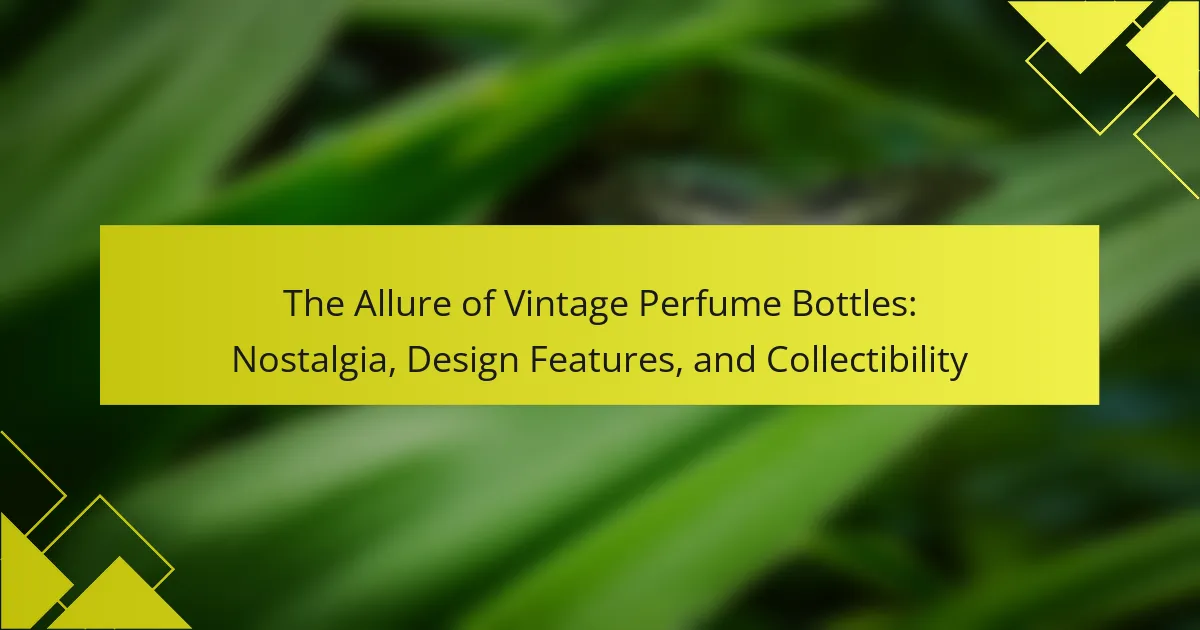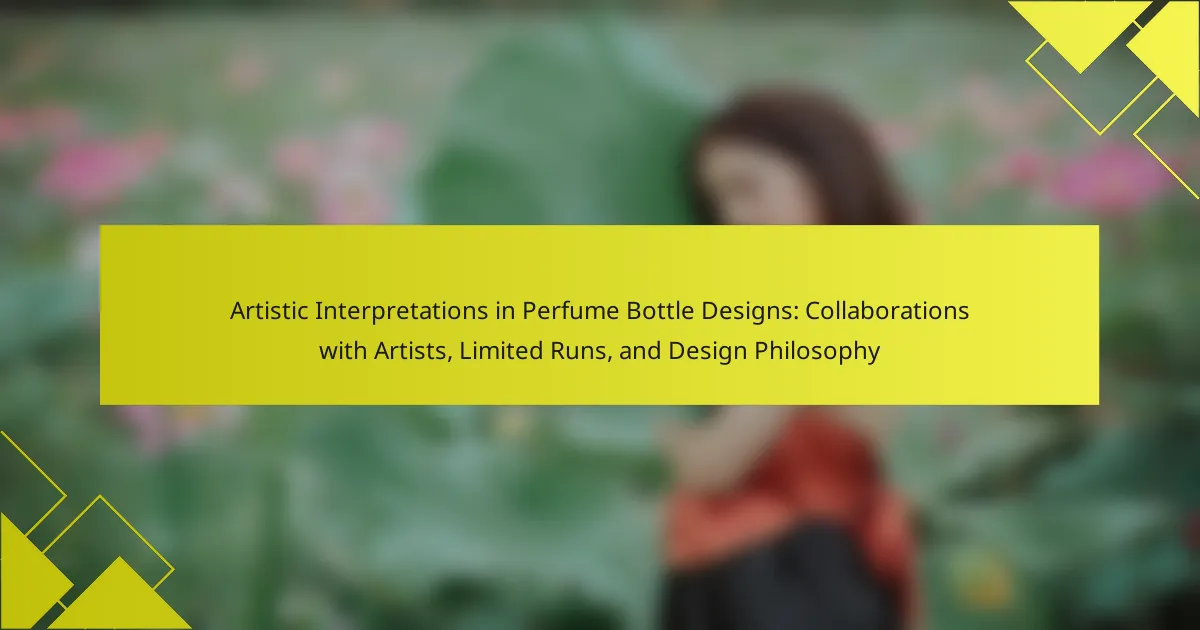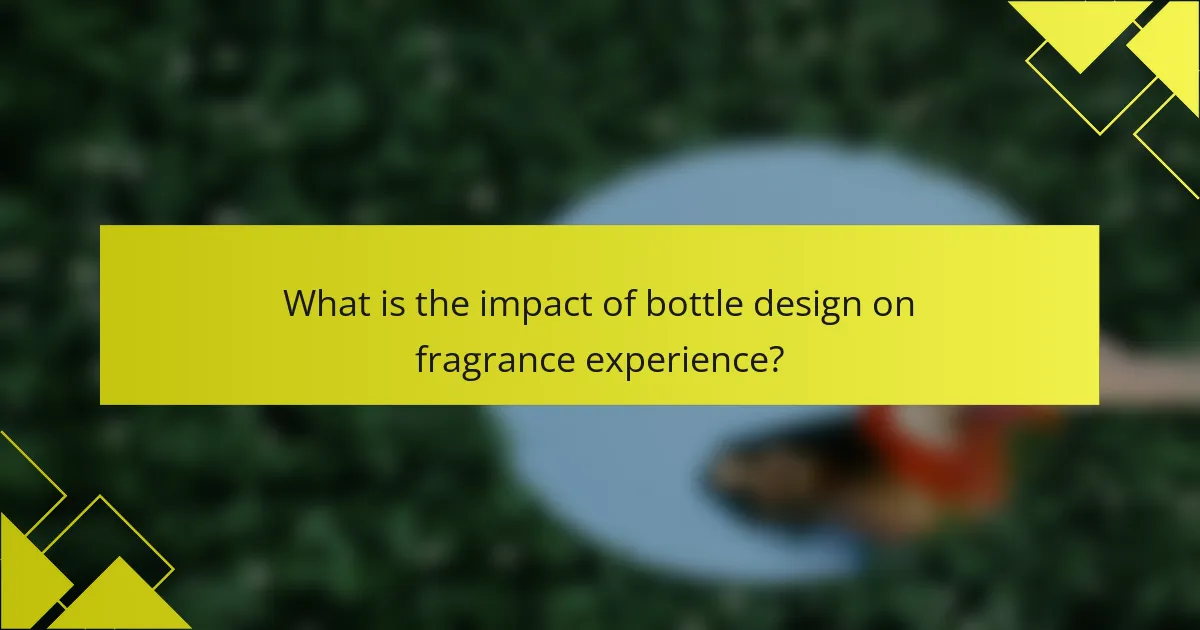
What is the impact of bottle design on fragrance experience?
Bottle design significantly influences the fragrance experience. The shape of a bottle can affect how a fragrance is perceived. For example, a sleek, modern design may suggest a fresh scent, while an ornate bottle may hint at a rich, complex fragrance. Color also plays a crucial role. Bright colors often evoke feelings of joy and energy, while darker hues may suggest sophistication or mystery.
Texture can enhance tactile engagement. A smooth surface may feel luxurious, whereas a textured finish can create a sense of authenticity. Research shows that consumers often associate specific bottle designs with certain scent profiles. A study published in the Journal of Sensory Studies found that bottle aesthetics can alter consumer expectations and perceived scent intensity.
Overall, bottle design shapes not only the aesthetic appeal but also the emotional and sensory connection to the fragrance.
How do shape, color, and texture influence fragrance perception?
Shape, color, and texture significantly influence fragrance perception. The shape of a bottle can evoke certain emotions and expectations about the scent inside. For example, angular shapes may suggest a more intense fragrance, while rounded shapes may imply softness. Color affects mood and can trigger specific associations; for instance, warm colors like red may hint at spicy scents, while cool colors like blue may suggest freshness. Texture plays a role in tactile engagement, impacting how consumers perceive the quality of the fragrance. A smooth texture may convey luxury, while a rough texture can imply a more organic essence. Research indicates that these design elements can alter consumer expectations and overall fragrance experience, as seen in studies on product packaging psychology.
What role does bottle shape play in consumer attraction?
Bottle shape significantly influences consumer attraction. The design of a bottle can evoke emotions and create a memorable brand identity. Research indicates that unique shapes can enhance perceived value. For instance, a study published in the Journal of Consumer Research found that consumers are more likely to choose products with distinctive packaging. The shape can also affect consumer perceptions of quality and luxury. Bottles with elegant curves may attract premium buyers. Moreover, ergonomic designs can improve usability, leading to positive consumer experiences. Overall, bottle shape plays a crucial role in marketing and consumer preference.
How does color affect emotional responses to fragrance?
Color significantly influences emotional responses to fragrance. Different colors evoke distinct feelings and associations. For example, warm colors like red and orange are often linked to excitement and passion. In contrast, cool colors such as blue and green are associated with calmness and tranquility. Research indicates that color can alter perception of scent intensity and pleasantness. A study published in the journal “Chemical Senses” found that participants rated fragrances as more pleasant when presented in warm-colored packaging. This demonstrates that color not only impacts emotional responses but also enhances the overall fragrance experience.
In what ways does texture enhance the tactile experience of a fragrance bottle?
Texture enhances the tactile experience of a fragrance bottle by providing sensory feedback during handling. A textured surface can create a more engaging interaction, making the bottle easier to grip. This tactile quality can evoke emotional responses, influencing consumer perception of the fragrance. Textures can also signify luxury or uniqueness, enhancing the overall appeal. For example, matte finishes may convey sophistication, while glossy surfaces suggest modernity. Research shows that tactile experiences can affect purchasing decisions, as consumers often prefer products that feel good in hand. Thus, texture plays a crucial role in the overall fragrance experience.
Why is bottle design important in the fragrance industry?
Bottle design is important in the fragrance industry because it influences consumer perception and purchasing decisions. The shape, color, and texture of a bottle can evoke emotions and create a brand identity. For example, a sleek, modern bottle may suggest sophistication, while a vintage design might evoke nostalgia. Research indicates that attractive packaging can increase a product’s perceived value. In fact, studies show that consumers often associate premium fragrances with high-quality packaging. Additionally, unique bottle designs can enhance shelf appeal and differentiate products in a competitive market. Overall, effective bottle design is crucial for branding and marketing within the fragrance industry.
How does bottle design contribute to brand identity?
Bottle design significantly contributes to brand identity by creating a visual representation of the brand’s values and personality. The shape of the bottle can evoke emotions and associations that align with the product’s intended experience. For example, a sleek, modern bottle may suggest sophistication, while a vintage design can evoke nostalgia. Color plays a critical role as well; specific hues can trigger emotional responses and influence consumer perceptions. Research shows that color can increase brand recognition by up to 80%. Texture adds another layer, as tactile elements can enhance the user experience and foster a deeper connection with the brand. Together, these design elements create a cohesive identity that distinguishes the brand in a crowded marketplace.
What are the psychological effects of bottle aesthetics on consumer choices?
Bottle aesthetics significantly influence consumer choices. The design elements such as shape, color, and texture create emotional responses. Attractive bottles can evoke feelings of luxury and quality. Consumers often associate unique designs with superior product performance. Research shows that 70% of purchasing decisions are made at the point of sale. A study by Underwood and Klein (2002) highlights that visually appealing packaging enhances perceived value. Additionally, color psychology indicates that certain colors can affect mood and perception. For instance, warm colors can create a sense of excitement. Overall, bottle aesthetics play a crucial role in shaping consumer preferences and purchasing behavior.
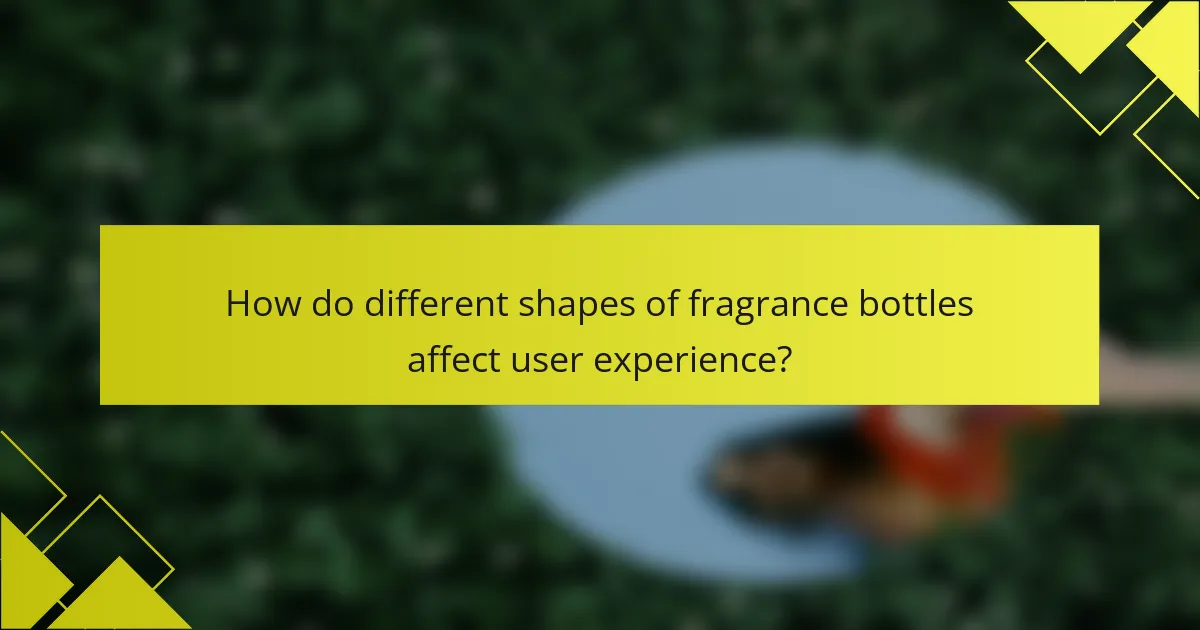
How do different shapes of fragrance bottles affect user experience?
Different shapes of fragrance bottles significantly affect user experience by influencing perception and usability. A bottle’s shape can evoke specific emotions and associations. For example, elegant shapes often suggest luxury, while playful designs can convey fun. Ergonomics also play a role; comfortable shapes enhance ease of use during application. According to a study published in the Journal of Consumer Research, bottle shape can impact consumer preference and purchase intention. Additionally, unique shapes can enhance shelf appeal, making products more memorable. Overall, the design of a fragrance bottle shapes the overall sensory experience and influences consumer behavior.
What are the most common bottle shapes used in the fragrance market?
The most common bottle shapes used in the fragrance market include rectangular, round, and oval designs. Rectangular bottles are often associated with modern and minimalist aesthetics. Round bottles typically convey a sense of softness and elegance. Oval bottles blend both shapes, providing a unique silhouette. These shapes cater to various consumer preferences and brand identities. The choice of shape can influence consumer perception and emotional response. For instance, angular designs may evoke sophistication, while softer shapes can suggest warmth. Overall, bottle shapes play a crucial role in the branding and marketing of fragrances.
How does each shape convey different messages about the fragrance?
Shapes of fragrance bottles convey distinct messages about the scent inside. Round shapes suggest softness and femininity, often associated with floral or sweet fragrances. Square shapes imply strength and stability, typically linked to woody or spicy scents. Tall, slender shapes evoke elegance and sophistication, commonly found in high-end or luxury fragrances. Short, wide shapes can indicate boldness and richness, often representing gourmand or intense scents. Each shape aligns with consumer expectations and emotional responses, influencing purchase decisions. Research shows that bottle design significantly affects consumer perception of the fragrance’s character and quality.
What consumer preferences exist regarding bottle shapes?
Consumers prefer bottle shapes that are aesthetically pleasing and functional. Popular shapes include cylindrical, square, and unique artistic designs. Cylindrical bottles are favored for their classic and ergonomic design. Square bottles often convey modernity and stability. Unique shapes can attract attention and create a memorable brand identity. Research indicates that 70% of consumers consider the bottle shape when purchasing fragrances. Additionally, consumers associate specific shapes with luxury and quality. For instance, a study by the Journal of Consumer Research found that consumers perceive irregular shapes as more innovative. These preferences significantly influence purchasing decisions in the fragrance market.
How does the shape of a bottle influence fragrance distribution?
The shape of a bottle significantly influences fragrance distribution. Different bottle shapes affect how the fragrance is released into the air. For instance, a wider bottle opening allows for a greater surface area, enabling quicker evaporation of volatile compounds. This leads to a more immediate and intense fragrance release. Conversely, a narrow neck restricts airflow, which can slow down the evaporation process. Bottles with a tapered design can also direct the fragrance more precisely. This design can enhance the perception of specific notes as they are released. Research shows that the geometry of the bottle can alter the way consumers perceive the scent. Studies indicate that shape affects not only the diffusion rate but also the overall fragrance experience.
What design features enhance the usability of fragrance bottles?
Ergonomic shapes enhance the usability of fragrance bottles. These shapes allow for a comfortable grip during application. A well-designed nozzle facilitates precise dispensing of the fragrance. Clear labeling on the bottle aids in easy identification of the scent. Lightweight materials improve portability for users. A secure cap prevents leakage and preserves the fragrance quality. Transparent or semi-transparent designs allow users to see the remaining product. These design features collectively improve the overall user experience with fragrance bottles.
How do different shapes affect the perception of fragrance longevity?
Different shapes of fragrance bottles can influence the perception of fragrance longevity. The design of a bottle affects how the fragrance is dispensed and how it interacts with air. For example, wider openings may allow more fragrance to evaporate quickly. This can create an impression of shorter longevity. Conversely, narrow openings can help retain the fragrance longer.
Research indicates that consumers often associate certain shapes with specific qualities. A study published in the Journal of Consumer Research found that rounded shapes are perceived as softer and more enduring. In contrast, angular shapes are often seen as sharp and fleeting.
Additionally, the material of the bottle can also play a role. Darker or opaque materials can protect the fragrance from light, potentially enhancing longevity. Overall, the shape of a bottle can significantly affect consumer perception of how long a fragrance lasts.
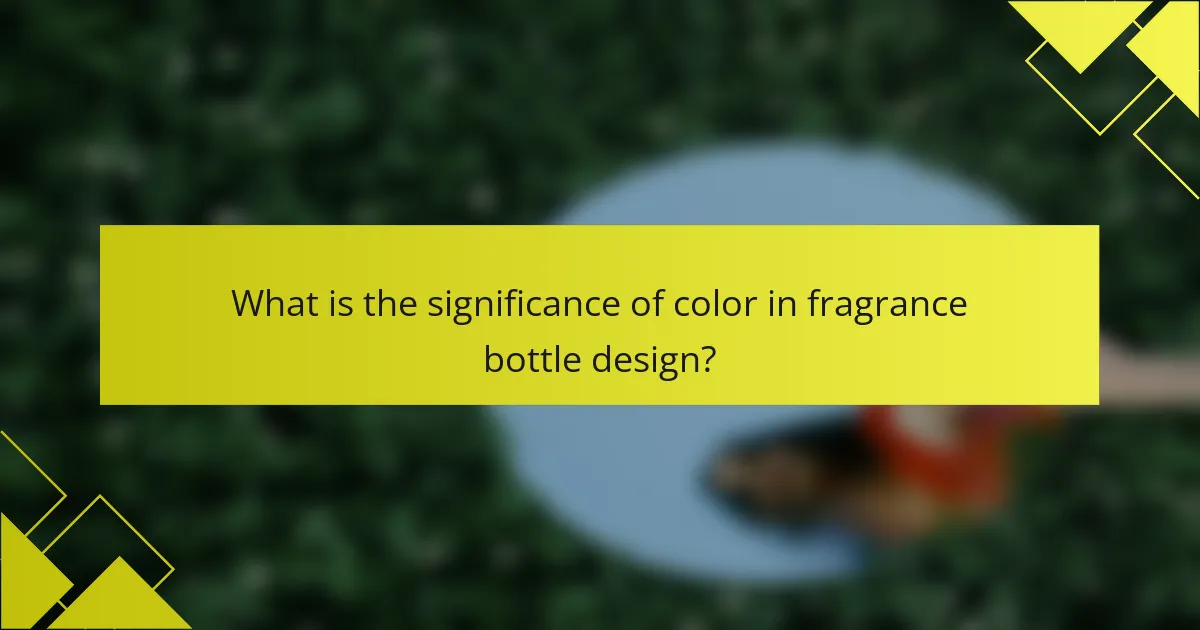
What is the significance of color in fragrance bottle design?
Color in fragrance bottle design is significant because it influences consumer perception and emotional response. Different colors evoke specific feelings and associations. For instance, blue often represents calmness and tranquility. Red can evoke passion and excitement. Brands use color to align with their fragrance’s intended message. Research shows that color can impact purchasing decisions. A study by the Institute for Color Research found that 85% of consumers make decisions based on color alone. Thus, color is a critical element in attracting customers and conveying brand identity.
How do colors evoke specific emotions related to fragrances?
Colors evoke specific emotions related to fragrances through psychological associations and cultural meanings. For instance, warm colors like red and orange often evoke feelings of passion and excitement. Cool colors such as blue and green tend to induce calmness and tranquility. Research shows that color perception influences our emotional responses to scents. A study published in the Journal of Environmental Psychology found that the color of packaging can significantly affect consumers’ mood and perception of fragrance quality. This indicates that colors not only enhance the aesthetic appeal of fragrance bottles but also shape the overall sensory experience.
What color schemes are most effective in attracting consumers?
Color schemes that are most effective in attracting consumers include combinations like blue and white, red and yellow, and black and gold. Blue and white evoke trust and cleanliness, making them popular in personal care products. Red and yellow create a sense of urgency and excitement, often used in food marketing. Black and gold suggest luxury and premium quality, appealing to high-end consumers. Research indicates that colors can influence purchasing decisions by up to 85%. A study by the Institute for Color Research found that consumers make a subconscious judgment about a product within 90 seconds, primarily based on color.
How does color choice reflect the fragrance’s notes or themes?
Color choice in fragrance bottles often mirrors the scent’s notes and themes. For instance, warm colors like red and orange typically signify spicy or fruity fragrances. Cool colors such as blue and green usually represent fresh or aquatic scents.
This correlation helps consumers quickly identify the fragrance’s character. Research indicates that color can evoke specific emotions linked to scent perception. A study by Labrecque and Milne (2013) found that consumers associate certain colors with particular fragrance attributes.
Thus, the color of a fragrance bottle serves as a visual cue, enhancing the overall experience by aligning with the scent’s olfactory profile.
What are the cultural implications of color in fragrance packaging?
Color in fragrance packaging significantly influences cultural perceptions and consumer behavior. Different cultures associate specific colors with distinct meanings and emotions. For instance, in Western cultures, black often symbolizes luxury and sophistication. In contrast, white is linked to purity and simplicity.
In Eastern cultures, red is frequently associated with good fortune and celebration. These cultural associations impact purchasing decisions and brand positioning. Studies indicate that color can enhance brand recognition by up to 80%.
Moreover, color choices in packaging can reflect cultural values, such as sustainability or tradition. Brands that align their color schemes with cultural expectations may foster stronger emotional connections with consumers. Therefore, understanding cultural implications of color is crucial for effective fragrance marketing.
How do cultural perceptions of color vary in fragrance marketing?
Cultural perceptions of color significantly influence fragrance marketing strategies. Different cultures associate specific colors with distinct meanings and emotions. For example, in Western cultures, the color white often symbolizes purity and freshness. In contrast, in some Eastern cultures, white can represent mourning and loss.
Red is perceived as a color of passion and love in many cultures, but in some contexts, it can signify danger or warning. Blue is generally associated with calmness and trust in Western societies, while in certain Middle Eastern cultures, it may represent protection.
These variations necessitate careful consideration in fragrance marketing. Brands must tailor their color choices in packaging to resonate with target audiences effectively. Research indicates that color can impact consumer behavior by up to 85% in purchasing decisions. Thus, understanding cultural color perceptions is crucial for successful fragrance marketing.
What strategies can brands use to select colors that resonate with target audiences?
Brands can use several strategies to select colors that resonate with target audiences. First, understanding psychological color theory is essential. Different colors evoke specific emotions and associations. For example, blue often conveys trust, while red can signify excitement.
Next, conducting market research helps brands identify color preferences among target demographics. Surveys or focus groups can reveal which colors appeal most to specific age groups or cultures.
Additionally, analyzing competitors can provide insights into effective color usage within the industry. Brands can differentiate themselves by choosing colors that stand out yet align with consumer expectations.
Finally, testing color combinations through A/B testing can determine which hues perform best in marketing materials. This data-driven approach ensures that the selected colors effectively engage the audience.
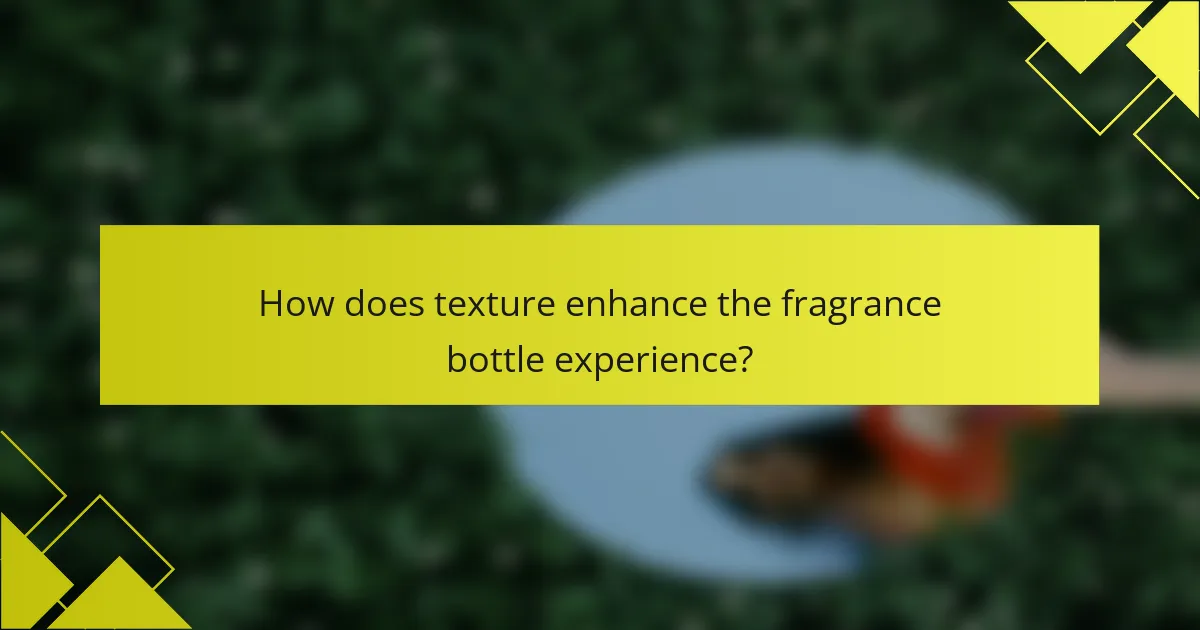
How does texture enhance the fragrance bottle experience?
Texture enhances the fragrance bottle experience by providing tactile feedback and visual appeal. The feel of a bottle can influence a consumer’s perception of the fragrance inside. A textured surface can evoke luxury and sophistication. Research indicates that consumers often associate certain textures with specific qualities, such as smoothness with elegance or roughness with authenticity. Furthermore, texture can affect grip and usability, making the bottle easier to handle. Studies show that pleasant textures can increase the likelihood of purchase. Overall, texture plays a crucial role in shaping the overall sensory experience of fragrance bottles.
What types of textures are commonly used in fragrance bottles?
Fragrance bottles commonly use textures such as smooth, matte, and embossed. Smooth textures provide a sleek and modern appearance. Matte finishes create a subtle and sophisticated look. Embossed textures add depth and tactile interest. Other textures include frosted, which diffuses light and enhances visual appeal. Textured surfaces can also evoke specific themes or emotions related to the fragrance. The choice of texture influences consumer perception and experience. For instance, luxurious fragrances often feature rich, tactile textures to convey opulence.
How does texture influence the perceived quality of a fragrance?
Texture significantly influences the perceived quality of a fragrance. The tactile sensation of a fragrance bottle can evoke specific emotions and expectations. For instance, a smooth, polished surface may suggest luxury and refinement. Conversely, a rough or matte texture might imply a more organic or artisanal quality. Research indicates that consumers often associate certain textures with specific fragrance notes. A study by Spence et al. (2014) found that participants rated fragrances in textured bottles higher in quality than those in plain bottles. This suggests that texture can enhance the overall sensory experience of a fragrance.
What role does texture play in the overall consumer experience?
Texture significantly influences the overall consumer experience by affecting perception and emotional response. It contributes to the tactile sensation when interacting with a product. For instance, a smooth texture can evoke feelings of luxury and sophistication. Conversely, a rough texture may suggest a more natural or organic quality. Research shows that consumers often associate texture with product quality and performance. According to a study published in the Journal of Consumer Research, tactile experiences can enhance product evaluations and increase purchase intentions. Therefore, texture plays a crucial role in shaping consumer attitudes and behaviors towards products.
How can brands leverage texture to differentiate their products?
Brands can leverage texture to differentiate their products by creating unique tactile experiences. Textures can evoke emotions and enhance product perception. For example, a matte finish may convey sophistication, while a glossy texture can suggest luxury. Research shows that consumers often associate certain textures with specific qualities. A study published in the Journal of Consumer Research found that textured packaging can influence buying decisions. Brands can also use texture to enhance user interaction. For instance, a raised logo on a bottle can create a memorable touchpoint. By strategically designing textures, brands can stand out in a crowded market.
What innovative materials are being used in fragrance bottle design?
Innovative materials in fragrance bottle design include bioplastics, recycled glass, and metal alloys. Bioplastics offer an eco-friendly alternative to traditional plastics. They are derived from renewable resources and reduce environmental impact. Recycled glass is increasingly used for its sustainability and aesthetic appeal. It allows brands to minimize waste while maintaining luxury appeal. Metal alloys provide durability and unique textures. They can also enhance the overall design through innovative shapes and finishes. These materials reflect a growing trend towards sustainability and design innovation in the fragrance industry.
How can texture enhance brand storytelling through fragrance bottles?
Texture enhances brand storytelling through fragrance bottles by creating a tactile experience that connects consumers to the brand’s narrative. The feel of a bottle can evoke emotions and memories. For instance, a smooth glass surface may suggest elegance and sophistication. Conversely, a rough or matte texture can communicate authenticity and naturalness.
Research shows that consumers often associate texture with quality. A study by Hagtvedt and Brasel (2017) found that textured packaging can lead to higher perceived value. This perception can influence purchasing decisions. Additionally, texture can reflect the fragrance itself. A floral scent might be paired with a soft, delicate texture, reinforcing the overall sensory experience.
By aligning the texture of the bottle with the brand’s story, companies can create a cohesive identity. This strategy enhances emotional engagement, making the product more memorable. Ultimately, texture serves as a silent yet powerful storyteller in the fragrance market.
What best practices should brands consider in fragrance bottle design?
Brands should prioritize functionality, aesthetics, and brand identity in fragrance bottle design. A functional bottle allows for easy dispensing and handling. Aesthetic appeal attracts consumers and enhances the product’s perceived value. Brand identity should be reflected in the design to create a strong connection with target customers.
Using quality materials is essential for durability and to convey luxury. The shape of the bottle should be ergonomic and visually striking to stand out on shelves. Color choices can evoke emotions and align with the fragrance notes. Texture adds a tactile element that can enhance the overall experience.
Research indicates that consumers are influenced by packaging design, impacting their purchasing decisions. A study by the Packaging Association found that 72% of consumers judge products by their packaging. This underscores the importance of thoughtful design in fragrance bottles.
The main entity of this article is bottle design in the fragrance industry. The article examines how shape, color, and texture of fragrance bottles significantly influence consumer perception and experience. It highlights the emotional and psychological effects of these design elements, discussing their impact on consumer attraction, brand identity, and purchasing decisions. Key findings from research studies are presented, showcasing how bottle aesthetics can alter expectations and enhance the overall fragrance experience. The article also outlines best practices for brands to consider in fragrance bottle design to effectively engage consumers.
